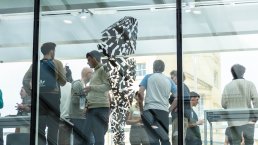Knutson's Conjecture on the Representation Ring
Abstract
Donald Knutson proposed the conjecture, later disproven and refined by Savitskii, that for every irreducible character of a finite group, there existed a virtual character such their tensor product was the regular character. In this talk, we disprove both this conjecture and its refinement. We then introduce the Knutson Index as a measure of the failure of Knutson's Conjecture and discuss its algebraic properties.
Decentralised Finance and Automated Market Making: Optimal Execution and Liquidity Provision
Abstract
Automated Market Makers (AMMs) are a new prototype of
trading venues which are revolutionising the way market participants
interact. At present, the majority of AMMs are Constant Function
Market Makers (CFMMs) where a deterministic trading function
determines how markets are cleared. A distinctive characteristic of
CFMMs is that execution costs for liquidity takers, and revenue for
liquidity providers, are given by closed-form functions of price,
liquidity, and transaction size. This gives rise to a new class of
trading problems. We focus on Constant Product Market Makers with
Concentrated Liquidity and show how to optimally take and make
liquidity. We use Uniswap v3 data to study price and liquidity
dynamics and to motivate the models.
For liquidity taking, we describe how to optimally trade a large
position in an asset and how to execute statistical arbitrages based
on market signals. For liquidity provision, we show how the wealth
decomposes into a fee and an asset component. Finally, we perform
consecutive runs of in-sample estimation of model parameters and
out-of-sample trading to showcase the performance of the strategies.
Hypergraphs for multiscale cycles in structured data (Yoon) Minmax Connectivity and Persistent Homology (Yim)
Abstract
Hypergraphs for multiscale cycles in structured data
Iris Yoon
Understanding the spatial structure of data from complex systems is a challenge of rapidly increasing importance. Even when data is restricted to curves in three-dimensional space, the spatial structure of data provides valuable insight into many scientific disciplines, including finance, neuroscience, ecology, biophysics, and biology. Motivated by concrete examples arising in nature, I will introduce hyperTDA, a topological pipeline for analyzing the structure of spatial curves that combines persistent homology, hypergraph theory, and network science. I will show that the method highlights important segments and structural units of the data. I will demonstrate hyperTDA on both simulated and experimental data. This is joint work with Agnese Barbensi, Christian Degnbol Madsen, Deborah O. Ajayi, Michael Stumpf, and Heather Harrington.
Minmax Connectivity and Persistent Homology
Ambrose Yim
We give a pipeline for extracting features measuring the connectivity between two points in a porous material. For a material represented by a density field f, we derive persistent homology related features by exploiting the relationship between dimension zero persistent homology of the density field and the min-max connectivity between two points. We measure how the min-max connectivity varies when spurious topological features of the porous material are removed under persistent homology guided topological simplification. Furthermore, we show how dimension one persistent homology encodes a relaxed notion of min-max connectivity, and demonstrate how we can summarise the multiplicity of connections between a pair of points by associating to the pair a sub-diagram of the dimension one persistence diagram.
14:15
Quantitative estimates for almost harmonic maps
Abstract
For geometric variational problems one often only has weak, rather than strong, compactness results and hence has to deal with the problem that sequences of (almost) critical points $u_j$ can converge to a limiting object with different topology.
A major challenge posed by such singular behaviour is that the seminal results of Simon on Lojasiewicz inequalities, which are one of the most powerful tools in the analysis of the energy spectrum of analytic energies and the corresponding gradient flows, are not applicable.
In this talk we present a method that allows us to prove Lojasiewicz inequalities in the singular setting of almost harmonic maps that converge to a simple bubble tree and explain how these results allow us to draw new conclusions about the energy spectrum of harmonic maps and the convergence of harmonic map flow for low energy maps from surfaces of positive genus into general analytic manifolds.
Cascading Principles - a major mathematically inspired art exhibition by Conrad Shawcross - extended until June 2026
Oxford Mathematics is delighted to be hosting one of the largest exhibitions by the artist Conrad Shawcross in the UK. The exhibition, Cascading Principles: Expansions within Geometry, Philosophy, and Interference, brings together over 40 of Conrad's mathematically inspired works from the past seventeen years. Rather than in a gallery, they are placed in the working environment of the practitioners of the subject that inspired them, namely mathematics.
Conrad Shawcross models scientific thought and reasoning within his practice. Drawn to mathematics, physics, and philosophy from the early stages of his artistic career, Shawcross combines these disciplines in his work. He places a strong emphasis on the nature of matter, and on the relativity of gravity, entropy, and the nature of time itself. Like a scientist working in a laboratory, he conceives each work as an experiment. Modularity is key to his process and many works are built from a single essential unit or building block. If an atom or electron is a basic unit for physicists, his unit is the tetrahedron.
Unlike other shapes, a tetrahedron cannot tessellate with itself. It cannot cover or form a surface through its repetition - one tetrahedron is unable to fit together with others of its kind. Whilst other shapes can sit alongside one another without creating gaps or overlapping, tetrahedrons cannot resolve in this way. Shawcross’ Schisms are a perfect demonstration of this failure to tessellate. They bring twenty tetrahedrons together to form a sphere, which results in a deep crack and ruptures that permeate its surface. This failure of its geometry means that it cannot succeed as a scientific model, but it is this very failure that allows it to succeed as an art work, the cracks full of broad and potent implications.
The show includes all Conrad's manifold geometric and philosophical investigations into this curious, four-surfaced, triangular prism to date. These include the Paradigms, the Lattice Cubes, the Fractures, the Schisms, and The Dappled Light of the Sun. The latter was first shown in the courtyard of the Royal Academy and subsequently travelled all across the world, from east to west, China to America.
The show also contains the four Beacons. Activated like a stained-glass window by the light of the sun, they are composed of two coloured, perforated disks moving in counter rotation to one another, patterning the light through the non-repeating pattern of holes, and conveying a message using semaphoric language. These works are studies for the Ramsgate Beacons commission in Kent, as part of Pioneering Places East Kent.
The exhibition Cascading Principles: Expansions within Geometry, Philosophy, and Interference is curated by Fatoş Üstek, and is organised in collaboration with Oxford Mathematics.
The exhibition is open 9am-5pm, Monday to Friday. Some of the works are in the private part of the building and we shall be arranging regular tours of that area. If you wish to join a tour please email @email.
The exhibition runs until 30 June 2026. You can see and find out more here.
Watch the four public talks centred around the exhibition (featuring Conrad himself).
The exhibition is generously supported by our longstanding partner XTX Markets.
Images clockwise from top left of Schism, Fracture, Paradigm and Axiom





